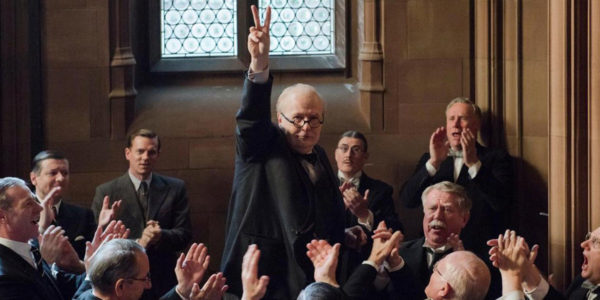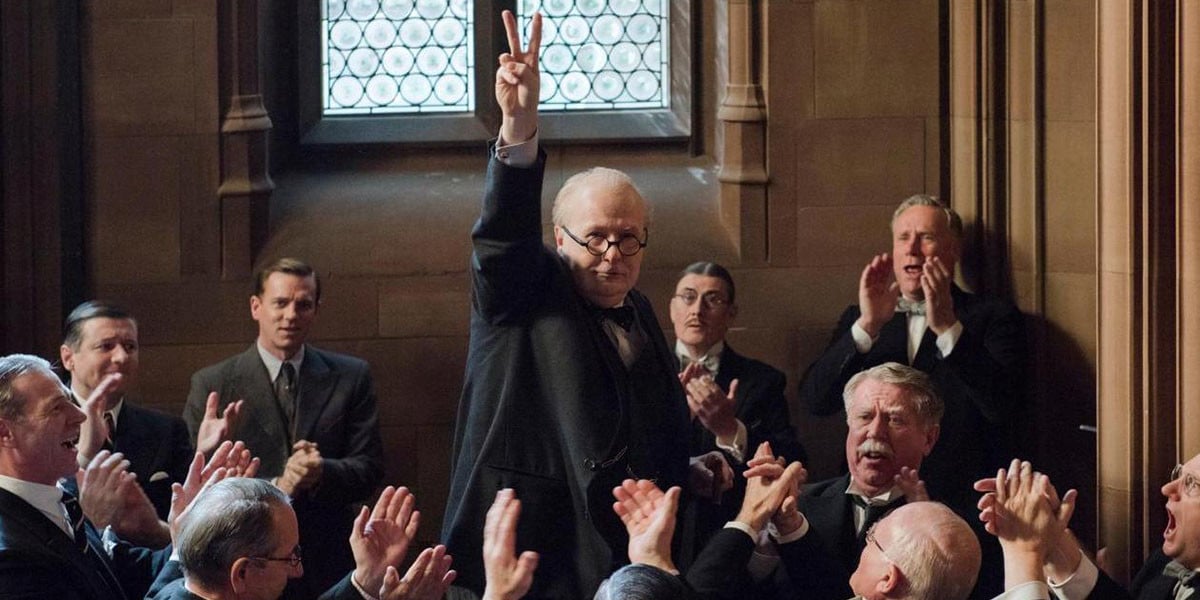
English director Joe Wright is known for his particular affinity for the sumptuous. Whether it’s his debut feature film “Pride & Prejudice” or the critically-lauded “Atonement,” Wright excels at examining grandiose moments of the past. Unfortunately, “Darkest Hour” appears to value those moments over an engaging story, moving from set piece to set piece without tying those scenes much together. Clearly an attempt at playing to the Academy crowd, “Darkest Hour” will most likely succeed in gathering a slew of nominations come Oscar season, especially for the performances of Gary Oldman and Ben Mendelsohn. However, a few great acting showcases and some inspired direction cannot create enough drive to sustain interest in the middling plot, leading “Darkest Hour” to be a movie of moments, but not a movie of momentum.
Perhaps the greatest aspect of “Darkest Hour” is a rousing performance from Oldman along with with the more subtle guide of Mendelson. Oldman throws himself fully into the role, and, with the help of some incredibly realistic prosthetics, transforms into the boisterous being that was Winston Churchill. Oldman uses that energy to great effect, from illustrating some of Churchill’s more comedic, outrageous behaviors to delivering the inspiration that defined Churchill as a leader for a generation of Brits. In contrast, Ben Mendelsohn plays King George IV as a man of great resolve, but also as a man with much to lose, should Germany prevail in the war. That conflict is apparent in every movement of Mendelsohn, down to the subtleties of his facial expressions. When the King’s understatement and Churchill’s boisterousness come to clash, the subsequent crackle creates some of the most humorous, and the most touching, moments of the entire film.
Beyond the great performances, Joe Wright uses his eye for grandeur to craft moments that instantly resonate with the viewer. From the sweeping wide angle shots of the historied Westminster Parliament to the grim aerial views of Europe under siege, Wright carefully engineers scenes to maximize their impact on the viewer’s emotion. The audience feels the heaviness of every tension and the bleakness of the situation as a whole. At his best, Wright invites the viewer into a richly designed world, a Britain of long ago filled with a gothic Parliament and bustling townsfolk. That world building can sweep a viewer right into “Darkest Hour,” making for some moments of great enjoyment.
Unfortunately, Wright’s direction can sometimes veer into self-indulgence, hitting every point directly and nearly always elevating subtext to text. At times it seems as though “Darkest Hour” only contains sweeping, wide angle shots or extreme close ups. This lack of directorial variety dulls even some of the more inspired moments of the story by creating a sense of sameness throughout the film. Even worse, some of Wright’s choices of closeups run the gamut from on-the-nose to downright confounding. “Darkest Hour” employs not one, not two, but three separate closeups of secretary Elizabeth Layton’s hands on a typewriter. Words were and are the defining skill of Churchill, but the viewer could understand that fact without it being broadcasted so blatantly. There is no subtlety in Wright’s camerawork and it is to the film’s detriment that it so completely doubts its audience’s intelligence. Moreover, when the closeups are not highlighting the obvious, they seem to serve no other specific purpose. In one far-too-long shot, the camera lingers directly on Churchill’s mouth and jowls as he speaks. But the shot comes at a completely unremarkable moment. There’s no rousing speech or pivotal plot point. The shot’s purpose could only be to highlight the prosthetic work on Oldman, but if that is the case, the message was surely lost on the viewer. It’s befuddling moments like those that leave a viewer to wonder how Wright’s directing can be both so explanatory and yet so ambiguous in a single film.
Though “Darkest Hour” works best when the viewer is caught in its epic moments and rousing speeches, when examining the film as a whole it’s hard to enjoy the scenes that connect the dots. Anthony McCarten’s script seems to value spectacle over sustained substance which plays to the worst impulses of Wright’s directing. The big moments are larger than life, but that only leaves the less developed scenes feeling smaller in comparison. The film moves at a breakneck pace, but yet, at the end of the film, one must wonder what changed, and what the purpose of watching the film was.
Joe Wright is a master of the period piece. His mastery of scenery and ambience creates films that are rich to behold, shimmering emblems of a time past. But in his latest, Wright has let his magic run out. “Darkest Hour” has all the surface gleam of a typical Wright film but is missing its core. Though there are standout performances and some typically inspired moments from Wright’s lens, overall “Darkest Hour” is lacking a strong enough base to stand on its own. For a film about a man as lively as Winston Churchill, “Darkest Hour” sure could use some energy.
Contact Zak Sharif at zsharif ‘at’ stanford.edu.
